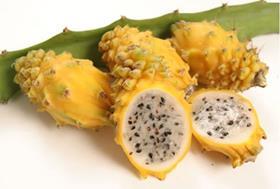
Korea has reportedly opened its doors to Colombian yellow pitahaya (or dragonfruit) after inspectors visited plantations located in Roldanillo (north of the Cauca Valley) and the municipality of Belén de Umbria (in Risaralda).
On 21-24 July, representatives of Korea’s Division of International Cooperation for Quarantine verified production, harvesting and post-harvest systems in the Latin American country, as well as the actions taken by suppliers to combat fruit fly (Anastrepha fraterculus and Ceratitis capitata complex), according to a report by El Mundo.com.
After evaluating the conditions under which the fruit is produced, the Korean delegation approved the official system of phytosanitary control coordinated by the Colombian Farming and Livestock Institute (ICA), the organisation’s CEO Luis Fernando Caicedo Lince told El Mundo.com.
As such, yellow dragonfruit grown in areas certified by ICA as controlled zones with a low incidence of fruit fly will be permitted access to the Korean market.
Currently, there are 478ha planted with dragonfruit in Colombia, of which 221ha are in commercial bearing, producing some 1,688 tonnes annually.
ICA has certified 39 farms for export, of which 25 are based in the Cauca Valley.
In 2009, Colombia exported 152 tonnes of dragonfruit to mainly the Netherlands, France, Germany and Brazil.






No comments yet